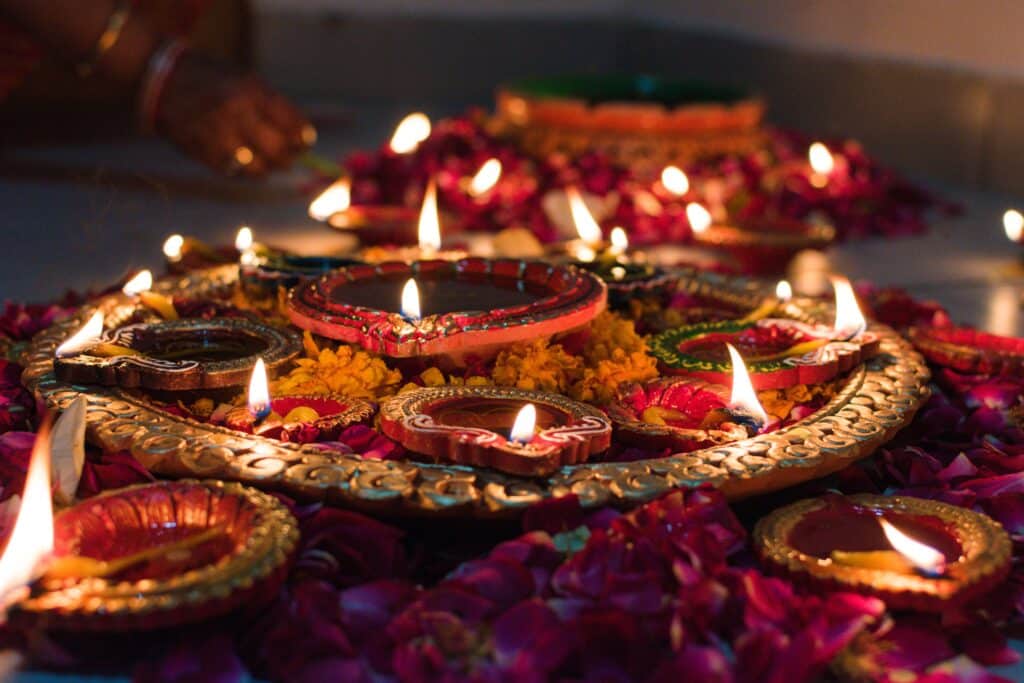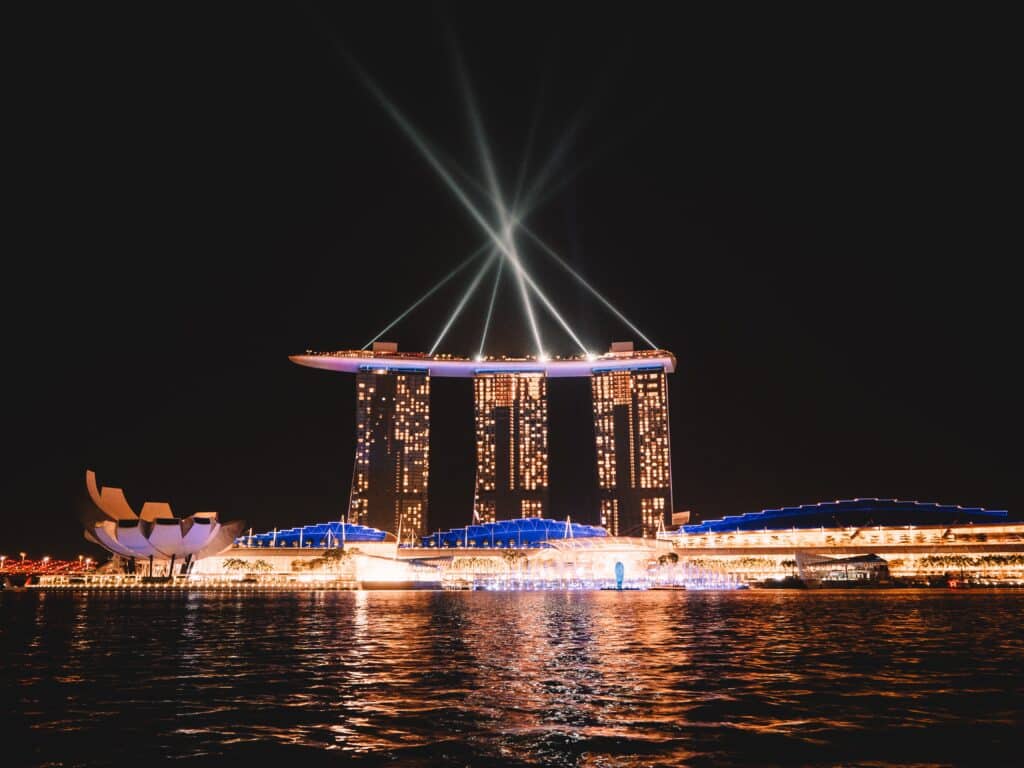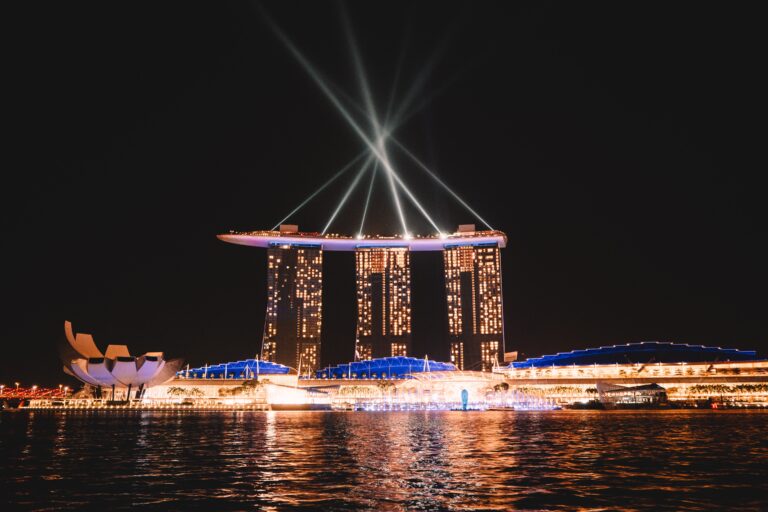Light holds significance in cultures all around the globe. And, over the centuries, lights have become an important part of religious traditions and celebrations.
Today, festivals of lights are celebrated tourist attractions in many cities around the world and continue to delight people of all ages and nationalities. Here, we look at some of the most famous and beautiful festivals of light during different holidays throughout the year.
1. Dev Dewali, India
Not to be confused with Diwali, Dev Diwali, also known as Dev Deepawali and Tripurotsav, is a festival of lights celebrated each year in Varanasi, a sacred city located on the Ganges river in northern India.
Dev Diwali is a celebration of Lord Shiva’s victory over the demon Tripurasur. It occurs 15 days after Diwali and is observed on the day of the full moon, known as Kartik Purnima. Many Indians believe that on this sacred day, all of the Gods descend on the city to bathe in the river.
On Dev Diwali, scores of pilgrims and tourists from all over the world arrive on the banks of the Ganges to take a dip in the water. They pray to the Hindu goddess Ganga, and when the sun goes down, they offer her flowers and lit lamps, called diyas—a tradition known as deepdaan.
During this holiday, the whole city is lit up with glowing lights and bright colors. Some describe this spectacular celebration of lights as appearing as though the stars have fallen to earth to beautify the city.

2. Macau Light Festival, Macau
During the month of December, Macau, an autonomous administrative region of China, becomes aglow with lights. Although the event overlaps with the Christmas season, the event isn’t associated with the holiday.
Instead, it is part of the celebration of Macau Special Administrative Region Establishment (SARE) Day, a public holiday that commemorates when China took control of the region. Tourism is a key part of the economy in Macau, and the event seeks to encourage winter holiday travelers to visit.
The Macau Light Festival takes place across the Macau Peninsula and on its islands. Each year brings a new theme, with light installations and projection mapping displays that correspond to it. In addition, the city hosts interactive games and live performances throughout the event.
3. Fête des Lumières, Lyon, France
The Fête des Lumières in Lyon, France originally began as part of the observance for the Feast of the Immaculate Conception, which pays tribute to the life and character of Mary, Jesus’ mother. However, the celebration has grown to symbolize the history of the city more than its religion.
The early 19th century was a difficult time in France, marked by social conflicts, foreign occupation, and natural disasters. In 1852, the city decided to erect a gold statue of Mary to serve as the protector of the city. Although the original date of the event was set for December 8, a flood required the city to postpone it, and they instead chose the date of the Feast of the Immaculate Conception as the backup.
Still, to this day, December 8th marks the start of the city’s Festival of Lights and, for many, the beginning of the Christmas holidays in France.
Residents of Lyon celebrate the Fête des Lumières by placing candles on their windowsills, and the city installs endless lights in public places, including projection mapping displays.
The event lasts for four days and includes celebrations across the city, including theater, music, and dance performances each night.
4. Vivid Sydney, Sydney, Australia
Vivid Sydney is an annual 23-day light festival held in Sydney, Australia. The event first launched in 2009 as a showcase of eco-friendly LED lighting sponsored by companies wishing to demonstrate their products. Since then, it has grown to become an innovative, illuminated arts show that draws creators from all over the world.
Typically, Vivid Sydney begins in late May and runs through mid-June. Many famous landmarks, like the Sydney Opera House, are decorated for the occasion, and 3D projections and light displays bedazzle many neighborhoods.
Concerts and dance parties take place throughout the city—and beginning in 2023, the festivities will also include a food festival featuring chefs from around the world.
5. Rodrigo de Freitas Lagoon, Rio de Janeiro, Brazil
Most people associate Rio de Janeiro with Carnaval, but that annual event isn’t the only time that the city throws a huge party. Each year, the Rio government holds a celebration to mark the lighting of the largest floating Christmas tree in the world.
The 278-foot-tall tree made its debut in 2014, featuring 3 million lights and requiring five generators mounted on barges to power it. After lighting the tree, the city hosts a public fireworks display, and live musical performances entertain large crowds.
Rodrigo de Freitas Lagoon is a popular celebration for locals and tourists alike, making it one of the most anticipated events during Christmastime in Brazil.
6. Pingxi Lantern Festival, Taipei, Taiwan
New Taipei City’s Pingxi Lantern Festival is a three-day event that begins on the 15th day of the first month in the lunar calendar. The festival, which the Discovery Channel calls “the second-biggest New Year’s Eve celebration in the world,” started as a regional event during the 1990s and is now a national tradition. During the festival, thousands of sky lanterns are released each day once the sun goes down.
The celebration takes place at three locations in the city, where event sponsors provide free lanterns to those who want to release them. Before lighting and releasing their lanterns, participants write a wish on the exterior.
The first two release locations, Jingtong Elementary School and Pingxi Junior High School, usually have creative lanterns in a variety of shapes and sizes. The final location, Shifen Sky Lantern Square, hosts the release of the large main lantern on the festival’s last day.
7. The Magnificent Mile Lights Festival, Chicago, U.S.
For the residents of the third largest city in the U.S., the Christmas season begins with Chicago’s annual Magnificent Mile Lights Festival, which takes place on the Saturday before Thanksgiving.
The largest nighttime parade in the U.S., the Magnificent Mile Lights Festival draws huge crowds. More than a million people line Michigan Avenue to watch the parade’s marching bands, enormous helium balloons, and festive floats pass by.
The celebration features more than 200 decorated trees and over a million lights. The evening culminates in an impressive fireworks display.
The Magnificent Mile Lights Festival traces its history back 50 years to when merchants on Greater North Michigan Avenue pulled resources to decorate trees in the shopping area. In 1992, Disney became a part of the celebration, and Disney characters are heavily featured in the parade.
8. Festival of Lights, Berlin, Germany
The Festival of Lights in Berlin, Germany has no religious ties. Instead, it seeks to bring together Germans from across the country and tourists from around the world to celebrate innovation and diversity. The event premiered in 2005 and is held during the autumn months.
Each year, the City of Berlin comes up with a unique theme for the festival and puts out an international call for artists to submit illuminated works. The best are chosen and erected in public areas across the city.
Many famed Berlin landmarks, like the church towers of the Nikolaikirche, the Brandenburg Gate, and the Berliner Dom, are illuminated during the festival, and musical and cultural performances take place at both theaters and outdoor gathering spaces.
9. Alumbrados EPM, Medellín, Colombia
The annual Alumbrados EPM festival in Medellín, Colombia began as a simple Christmas tree-lighting ceremony at Plaza Mayor, which is now home to the city’s convention center.
In 1955, the country’s largest utility company, Empresas Públicas de Medellín, took over the celebration and began hosting light displays of increasing complexity.
Today, the event spans more than 100 locations within the city. In addition to gorgeous light displays, the festival includes musical concerts, dance performances, and special activities for children and families.
Dates vary each year, but the event usually begins with a large celebration in early December and continues into early January, ending sometime after Three King’s Day on January 6th.

10. i Light Marina Bay Festival, Singapore
Like Vivid Sydney, the i Light Marina Bay Festival in Singapore began in 2010 as a way to demonstrate the potential of energy-efficient lighting. The Singapore Urban Redevelopment Authority organizes the annual event, which usually takes place for three weeks or more during the summer.
Each year, the event expands to include more light displays. Works from both Singaporean and international artists are featured, and each exhibit uses only energy-saving lighting technology.
Along with the light exhibits, the i Light Marina Bay Festival features an array of live performances and a food festival. All of the installations are open to the public and can be viewed free of charge, but some concerts and tours have an admission fee, which varies based on the event.
11. Jokkmokk Light Festival, Jokkmokk, Sweden
The stunning beauty of the Arctic winter comes alive at the Jokkmokk Light Festival, a tradition celebrated in the heart of Swedish Lapland. After the hiatus caused by the COVID-19 pandemic, this dazzling event is back to light up the dark and chilly northern nights.
The town of Jokkmokk, closely collaborating with local artists and cultural organizations, hosts this festival that takes place in the peak of winter, usually in February. The town’s winter landscape is transformed by light installations ranging from simple strands of lights to complex 3D projections on historic buildings and snowy forests.
Beyond the breathtaking light displays, the festival also features cultural activities like concerts, workshops, and lectures. Visitors have the unique opportunity to immerse themselves in Sami traditions, with a chance to taste local cuisine and learn about the stories and customs of the region’s indigenous people. The soft glow of the lights, combined with the blanket of snow covering the landscape, is memorable.
Frequently Asked Questions (FAQs)
What religions have a festival of light?
Several religions celebrate a festival of light, including Hinduism, Jainism, Sikhism, and Judaism.
In Hinduism, the most prominent festival is Diwali, which celebrates the victory of light over darkness and honors the goddess Lakshmi. Jains celebrate Diwali as well, marking the spiritual victory of Lord Mahavira.
Those that are Jewish celebrate Hanukkah, which represents the rededication of the Second Temple in Jerusalem and the miracle of the oil that lasted eight days.
For Buddhists, the festival of Vesak honors the birth, enlightenment, and death of the Buddha, often featuring the lighting of lamps.
For Christians, Christmas isn’t just about Santa. Some Christian traditions observe Advent and Christmas with candles and lights. One of the most famous American Christmas trees is the Rockefeller Tree in New York, and after the mayor lights the tree, people gather for live entertainment.
And for Sikhs, their Festival of Lights is known as Bandi Chhor Divas. Just like Diwali, Sikhs light diyas (oil lamps) around their homes and gurdwaras (temples) to symbolize the triumph of light over darkness.
What is the most famous Festival of Lights?
The most famous Festival of Lights is Diwali, celebrated primarily in Hindu culture. The holiday symbolizes the victory of light over darkness and good over evil. It honors Lakshmi, the goddess of wealth and prosperity, and features various traditions such as lighting diyas, decorating homes with rangoli, and celebrating with fireworks and feasts. Diwali is celebrated in countries with large South Asian communities, like India, Nepal, Malaysia, and Fiji. There is also significant South Asian population in the United Kingdom, especially in London and Leicester.
Where does the name Diwali come from?
The name “Diwali” comes from the Sanskrit word “Deepavali,” which in English is the term for “row of lights.” Hindus celebrate both Diwali and Dev Diwali. Diwali is celebrated on Amavasya (new moon) of the Hindu month of Kartik. Dev Diwali, also known as Dev Deepawali and Tripurotsav, is a festival of lights celebrated each year in Varanasi in northern India, fifteen days after the end of Diwali. Similar to Diwali, during Dev Diwali people light diyas (oil lamps) and decorate their homes to invite divine blessings.
What are the origins of the Lantern Festival in China?
The origins of the Lantern Festival in China date back over 2,000 years, celebrating the end of the Lunar New Year festivities. Buddhist monks would light lanterns to honor Buddha, a practice that later spread to the Chinese population and evolved into the Lantern Festival celebration known today. The holiday marks the first full moon of the new lunar year and the end of the Chinese New Year. Celebrations include lion and dragon dances, parades, holiday lights, lantern displays, and fireworks.
What are some common traditions associated with the Festival of Lights in Lyon, France?
The Fête des Lumières in Lyon, France originally began as part of the observance for the Feast of the Immaculate Conception, which pays tribute to the life and character of Mary, Jesus’ mother. However, the celebration has grown to symbolize the history of the city more than its religion.
Residents of Lyon celebrate the Fête des Lumières by placing candles on their windowsills, and the city installs endless lights in public places, including projection mapping displays. The event lasts for four days and includes celebrations across the city, such as theater, music, and dance performances each night. Food stalls and local restaurants showcase Lyonnaise cuisine, allowing attendees to enjoy traditional dishes, and neighborhoods set up window displays and decorations.
How do they celebrate the Festival of Lights in Thailand?
In Thailand, the Festival of Lights is primarily during Loi Krathong, which usually falls in November. It’s celebrated by making and releasing decorated floating baskets made in the shape of open lotus flowers, called “krathongs,” onto waterways as an offering to the water goddess, accompanied by the lighting of candles and incense.
Another prominent celebration includes releasing sky lanterns (khom loi) into the air, especially in the northern city of Chiang Mai where the Yi Peng festival coincides with Loy Krathong. Many people say a short prayer or write notes before lighting them. Yi Peng means “full moon,” so the holiday is always celebrated during the full moon of the second lunar month of the Lanna calendar. You’ll see parades, traditional dances, live music, food stalls, and fireworks.

